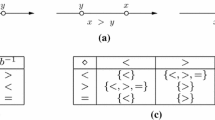Abstract
Many temporal applications like planning and scheduling can be viewed as special cases of the numeric and symbolic temporal constraint satisfaction problem. Thus we have developed a temporal model, TemPro, based on the interval Algebra, to express such applications in term of qualitative and quantitative temporal constraints. TemPro extends the interval algebra relations of Allen to handle numeric information. To solve a constraint satisfaction problem, different approaches have been developed. These approaches generally use constraint propagation to simplify the original problem and backtracking to directly search for possible solutions. The constraint propagation can also be used during the backtracking to improve the performance of the search. The objective of this paper is to assess different policies for finding if a TemPro network is consistent. The main question we want to answer here is “how much constraint propagation is useful” for finding a single solution for a TemPro constraint graph. For this purpose, we have experimented by randomly generating large consistent networks for which either arc and/or path consistency algorithms (AC-3, AC-7 and PC-2) were applied. The main result of this study is an optimal policy combining these algorithms either at the symbolic (Allen relation propagation) or at the numerical level.
Similar content being viewed by others
Explore related subjects
Discover the latest articles, news and stories from top researchers in related subjects.References
J. F. Allen. (1983). Maintaining knowledge about temporal intervals. CACM 26: 832–843.
C. Bessière. (1994). Arc-consistency and arc-consistency again. Artificial Intelligence 65: 179–190.
C. Bessière, E. Freuder, & J. C. Regin. (1995). Using inference to reduce arc consistency computation. IJCAI'95, Montréal, Canada, pages 592–598.
C. Bessière, A. Isli, & G. Ligozat. (1996). Global consistency in interval algebra networks: Tractable subclasses. ECAI'96, Budapest, Hongrie.
C. Bessière. (1996). A simple way to improve path consistency processing in interval algebra networks, AAAI'96, Portland, 375–380.
T. L. Dean & D. V. McDermott. (1987). Temporal database management. Artificial Intelligence 32: 1–55.
M. Ghallab & A. Mounir-Alaoui. (1989). Managing efficiently temporal relations through indexed spanning trees. Proc. IJCAI'89, Menlo Park, Calif, USA, pages 1297–1303.
R. M. Haralick & G. L. Elliott. (1980). Increasing tree search efficiency for constraint satisfaction problems. Artificial Intelligence 14: 263–313.
H. A. Kautz & P. B. Ladkin. (1991). Integrating metric and qualitative temporal reasoning. AAAI-91, Anaheim, CA, pages 241–246.
A. Koomen. (1987). The timelogic temporal reasoning system in common lisp. Technical Report TR231, Universit de Rochester, pages 241–246.
P. B. Ladkin & A. Reinefeld. (1992). Effective solution of qualitative interval constraint problems. Artificial Intelligence 57: 105–124.
G. Ligozat. (1991). On generalized interval calculi. AAAI91, Anaheim, CA, pages 234–240.
I. Meiri. (1996). Combining qualitative and quantitative constraints in temporal reasoning. Artificial Intelligence 87: 343–385.
A. K. Mackworth. (1977). Consistency in networks of relations. Artificial Intelligence 8: 99–118.
Mohr & Henderson. (1986). Arc and path consistency revisited. Artificial Intelligence 28: 225–233.
U. Montanari. (1974). Fundamental properties and applications to picture processing. Information Sciences 7: 95–132.
J. F. Rit. (1988). Modélisation et propagation de contraintes temporelles pour la planification. Thèse de Doctorat à l'INPG.
D. Sabin & E. C. Freuder. (1994). Contradicting conventional wisdom in constraint satisfaction. Proc. 11th European Conference on Artificial Intelligence, Amsterdam, Hollande, pages 125–129.
H. Tolba, F. Charpillet & J. P. Haton. (1991). Representing and propagating constraints in temporal reasoning. AI Communications 4: 145–151.
E. Tsang. (1994). Foundation of Constraint Satisfaction. Academic Press.
R. E. Valdéz-Pérez. (1989). The satisfiability of temporal constraint networks. IJCAI'89, Menlo Park, Calif, USA, pages 1291–1296.
P. van Beek. (1989). Approximation algorithms for temporal reasoning. IJCAI'89, Menlo Park, Calif, USA, pages 1291–1296.
P. van Beek. (1990) Reasoning about qualitative temporal information. AAAI-90, Boston, MA, pages 297–326.
P. van Beek. (1992). Reasoning about qualitative temporal information. Artificial Intelligence 58: 297–326.
P. van Beek & D. W. Manchak. (1996). The design and experimental analysis of algorithms for temporal reasoning. Journal of Artificial Intelligence Research 4: 1–18.
M. Vilain & H. Kautz. (1986). Constraint propagation algorithms for temporal reasoning. AAAI-86, Philadelphia, PA, pages 377–382.
R. J. Wallace. (1993). Why AC-3 is almost always better than AC-4 for establishing arc consistency in CSPs. IJCAI'93, Chambery, France, pages 239–245.
Author information
Authors and Affiliations
Rights and permissions
About this article
Cite this article
Mouhoub, M., Charpillet, F. & Haton, J.P. Experimental Analysis of Numeric and Symbolic Constraint Satisfaction Techniques for Temporal Reasoning. Constraints 3, 151–164 (1998). https://doi.org/10.1023/A:1009769509401
Issue Date:
DOI: https://doi.org/10.1023/A:1009769509401




